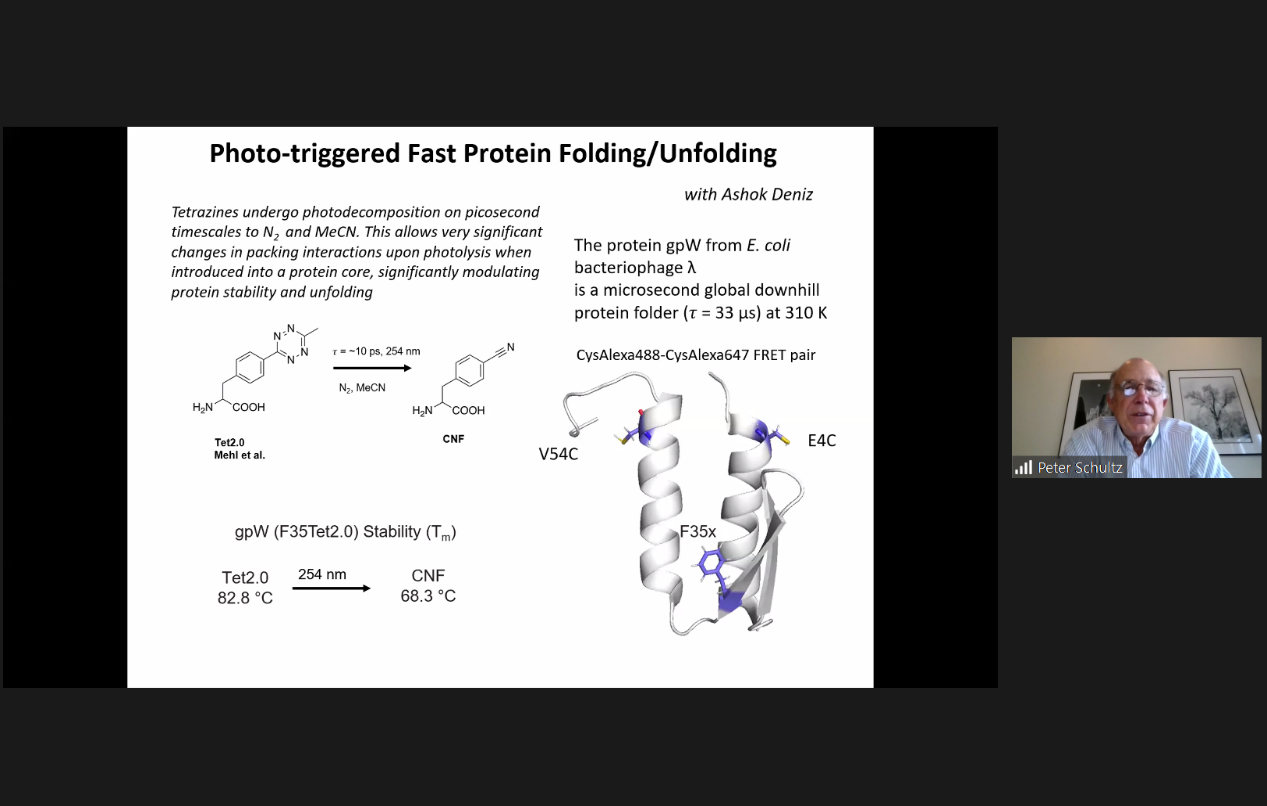Peter G. Schultz, a member of the US National Academy of Sciences and President/CEO of Scripps Research and Chen Peng, Professor of the College of Chemistry and Molecular Engineering and Director of the Department of Chemical Biology at Peking University, addressed the second session of the Chemical Biology High-end Forum. The forum. held at the State Key Laboratory of Medicinal Chemical Biology on the morning of April 26, was chaired by Prof. Chen Quan, Director of the State Key Laboratory, and attended by Prof. Xi Zhen from Nankai University, Research Fellow Zhang Hongkai from Nankai University, and Research Fellow Liu Tao from Peking University. The forum was conducted online, attracting more than 500 students and teachers from inside and outside the university. Meanwhile, the forum was also broadcast live to the public through Research Cloud and other platforms, with a total of more than 22,000 viewers.
As the pioneer of GCE (Genetic Code Expansion) technology, Prof. Peter G. Schultz presented "Synthesis at the Interface of Chemistry and Biology", introducing the application of GCE technology to antibody-drug coupling, protein-protein/nucleic acid interaction resolution, protein folding and stability regulation, live bacterial vaccine preparation, and transgenic mice containing 21 amino acid extension genetic codons. He also presented the recent pioneering work of his group in combining chemical and biological research to create new molecular systems, such as the development of unnatural bases, the discovery of chimeric genomes, and the construction of yeast-bacterial hybrids.


Prof. Chen Peng presented his frontier work in the interface between chemistry and biology under the title of "Bioorthogonal Chemistry Unveils Spatial-Temporal Biology". He presented his work on the use of bioorthogonal reactions combined with GCE technology to achieve time-resolved regulation of kinase and protease activities, discovery of specific substrates for specific enzymes, time-specific proteomics studies, time-specific labeling of the mitochondrial proteome, and tumor-specific T cell isolation.


After the presentation, the two experts participated in an in-depth discussion and exchange with the conference guests and audience. When asked about his advice for graduate students, Prof. Peter G. Schultz drew on his own academic experience as an example and suggested that it is important for graduate students to learn how to perform research and to carry out work that excites them, rather than staying in their comfort zone. Prof. Chen Peng looked forward to developing more chemical biology tools and bioorthogonal reactions to study protein function, cell-cell interactions, and other directions. Both experts also answered scientifically relevant questions from the guests and the audience. The whole forum was interactive and active amid strong academic atmosphere.
Peter G. Schultz is a member of the US National Academy of Sciences, President/CEO of Scripps Research, Founding Director of GNF, Founding Director of Calibr, and Founder of Affymax Research Institute, Syrrx Kalypsys, Phenomix, Symyx Therapeutics, Ilypsa, Ambrx, Ardelyx, and Wildcat Technologies. Peter G. Shultz is an international pioneer in the field of chemical biology and one of the pioneers in the cross-field of chemistry and life sciences, such as catalytic antibodies, genetic codon expansion, and "high-throughput" screening. His main research interests include combinatorial chemistry, catalytic antibodies, molecular directed evolution, the use of GCE technology to create biomolecules with novel chemical and biological properties, and the use of cells to screen for small molecules with novel biological activities.
Chen Peng is Professor of the College of Chemistry and Molecular Engineering and Director of the Department of Chemical Biology at Peking University, Senior Research Fellow of the Peking University-Tsinghua Center for Life Sciences, and Section Chairman of the Peking University Interdisciplinary Degree Committee. His research focuses on the use of chemical biology tools and bioorthogonal reactions to study protein functions and protein-protein interactions in living systems. Specifically, these include bioorthogonal reactions and chemical tool development, application of photo-crosslinking probes to protein engineering and omics, and development of chemical biology tools for probing the interactions between biomolecules and cells in immune system regulation and intervention.